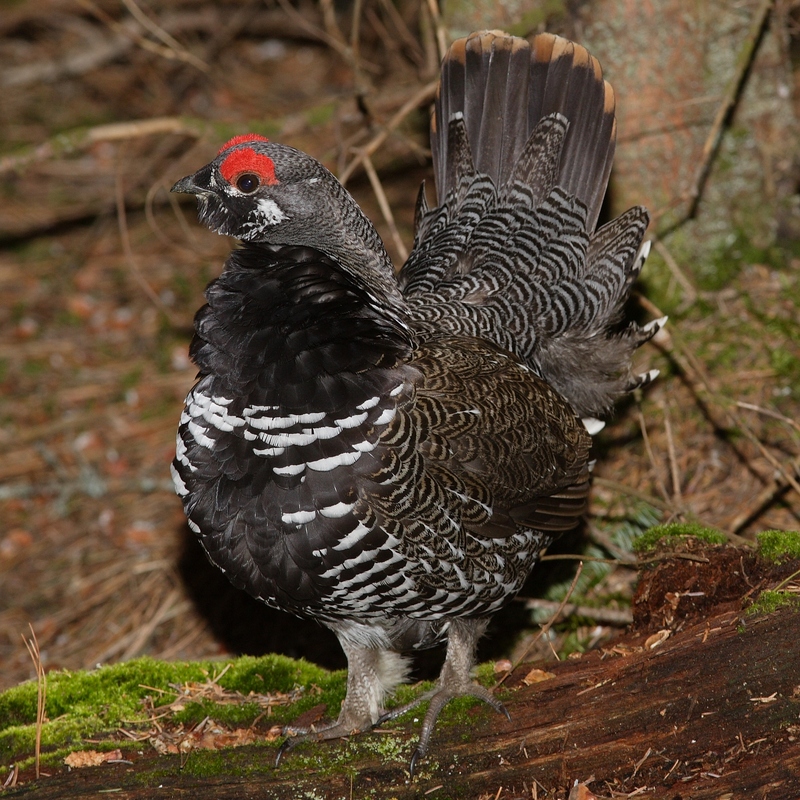|
| Query: spotted grouse | Result: 7th of 18 | |
Spruce Grouse (Falcipennis canadensis) - Wiki
| Subject: | Spruce Grouse (Falcipennis canadensis) - Wiki
| |

| Resolution: 1536x1536
File Size: 1422571 Bytes
Date: 2007:04:21 19:46:19
Camera: Canon EOS-1D Mark II (Canon)
F number: f/11.3
Exposure: 1/250 sec
Focal Length: 300/1
Upload Date: 2007:10:25 17:46:56
|
Spruce Grouse
From Wikipedia, the free encyclopedia
[Photo] Spruce Grouse (Falcipennis canadensis) male. Algonquin Provincial Park, Ontario, Canada. Date 2007/04. Author Mdf (http://commons.wikimedia.org/wiki/User:Mdf) | Permission is granted to copy, distribute and/or modify this document under the terms of the GNU Free Documentation License, Version 1.2 or any later version published by the Free Software Foundation; with no Invariant Sections, no Front-Cover Texts, and no Back-Cover Texts. A copy of the license is included in the section entitled "GNU Free Documentation License". |
The Spruce Grouse, Falcipennis canadensis, is a medium-sized grouse. Their breeding habitat is the boreal forests or taiga across Alaska and Canada. It also occurs in the boreal forest that extends into the United States' northern border states. They nest on the ground in dense growth.
Adults have a long square black tail, brown at the end. Adult males are mainly grey with a black breast with white bars, a black throat and a red patch over the eye. Adult females are mottled brown with dark and white bars on the underparts. The Franklin's Grouse subspecies, F. c. franklinii, lacks the brown ends on the tail.
They are permanent residents. Some move short distances by foot to a different location for winter.
These birds forage on the ground or in trees in winter. The caeca, digestive sacs in the intestines, increase in size to support this bird's winter diet of conifer needles. In summer, they also eat berries, green plants, and some insects.
The Spruce Grouse has great confidence in its camouflage, and will often stay still even when approached within a few feet (1 m). It is this characteristic that has earned them the nickname "Fool Hens". During the winter months, however, the Spruce Grouse will become very skittish due to a lack of camouflage; they take flight when approached within 20-150 feet (6-45 m). A male on territory makes a drumming sound by flapping his wings.
http://en.wikipedia.org/wiki/Spruce_Grouse
| The text in this page is based on the copyrighted Wikipedia article shown in above URL. It is used under the GNU Free Documentation License. You may redistribute it, verbatim or modified, providing that you comply with the terms of the GFDL. |
|
Comments |
|---|
| | Guest |
|
Scientific Name: Falcipennis canadensis (Linnaeus, 1758)
Common Names: Spruce Grouse, Canada Grouse, Spotted Grouse, Taiga Grouse
French: Tétras du Canada German: Tannenhuhn Spanish: Gallo canadiense
Taxonomy: Tetrao canadensis Linnaeus, 1758, Hudson Bay.
Synonyms:
Canachites canadensis (Linnaeus, 1758)
Dendragapus canadensis (Linnaeus, 1758) |
^o^
Animal Pictures Archive for smart phones
^o^
|
|
|

